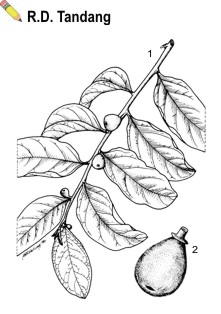Record Number
1469
PROSEA Handbook Number
2: Edible fruits and nuts
Taxon
Anacolosa frutescens (Blume) Blume
Protologue
Mus. Bot. Lugd. Bat. 1: 251, f. 46 (1850).
Family
OLACACAE
Chromosome Numbers
2n = unknown
Synonyms
Anacolosa heptandra Maing. ex Masters (1875), Anacolosa luzoniensis Merr. (1909).
Vernacular Names
Galo nut (En). Indonesia: kopi gunung (West Java), tangki leuweung (Sundanese), belian landak (Iban, Borneo). Philippines: aluloi, gálo (Tagalog), matoboto (Samar-Leyte, Bisaya), yupa (Gaddang).
Origin and Geographic Distribution
Galo nut occurs in Burma, Andaman & Nicobar Islands, eastern Thailand, Peninsular Malaysia, Sumatra, Java, Borneo, north-eastern Sulawesi, the Moluccas and the Philippines.
Uses
The pulp and kernel may be eaten fresh, although the fruit is usually boiled to bring out the delicious taste. The kernel can also be roasted. Possibilities to process kernel or pulp have not been explored. The wood is used for house posts.
Production and International Trade
Galo nut is found mainly in backyards and forests as volunteer trees. Only now is its potential for commercial cultivation being considered.
Properties
A mature galo nut fruit weighs 6—18 g. The green pulp which is about 64% of fresh fruit weight has about 76% moisture. The kernel weighs 0.8—2.8 g and has 10% moisture. The dry pulp and kernel contain respectively: protein 9.5% and 10.7%, fat 4.5% and 7.5%, carbohydrates 70.8% and 75.5%, fibre 7.2% and 3.7%, and ash 7.9% and 2.9%. Shelling recovery is high, ranging from 73% to 85%.
The wood is pale reddish-brown, hard and heavy, but said to be not durable.
The wood is pale reddish-brown, hard and heavy, but said to be not durable.
Botany
Erect shrub or tree, 5—25(—30) m tall. Leaves variable in shape and size, elliptic or elliptic-oblong to lanceolate, (6.6—)7—15(—22) cm x (3—)4—6.5(—12) cm; petiole 5—7(—10) mm long. Flowers on short warts or tubercles, (2—)5—15 per fascicle; calyx cupshaped, with 5—7 short lobes, ca. 3 mm in diameter; petals (5—)6(—7), ovate-lanceolate, connate about halfway, 2—3 mm x 1—1.5 mm, green-white; stamens 5—7. Fruit a drupe, obovoid-ellipsoid to oblongoid, (1.5—)1.8—2(—2.5) cm long, (1.2—)1.5—2 cm in diameter, yellow to orange, on stout pedicel up to 8 mm long; pulp 3.5—5.9 mm thick. Seed 1 with copious albumen.
Very little is known about growth and development. Germination and early growth proceed slowly. There is no information about the length of the juvenile phase. The fruiting season in the Philippines is from March to July, with a peak in April and May.
Two other Anacolosa species occur in Malesia on New Guinea and the Solomon Islands. In Burma, Thailand and Indochina more species occur. It is not known whether the kernels of those species are edible.
Very little is known about growth and development. Germination and early growth proceed slowly. There is no information about the length of the juvenile phase. The fruiting season in the Philippines is from March to July, with a peak in April and May.
Two other Anacolosa species occur in Malesia on New Guinea and the Solomon Islands. In Burma, Thailand and Indochina more species occur. It is not known whether the kernels of those species are edible.
Image
 | Anacolosa frutescens (Blume) Blume - 1, fruiting branch; 2, fruit |
Ecology
Galo nut grows well at low and medium altitudes (up to 700 m, rarely 1400 m) in shady environments without a pronounced dry season.
Agronomy
Since galo nut has not been grown, even experimentally, as an orchard crop, almost nothing is known about its cultural requirements. There seem to be no serious diseases but exposed roots have been damaged by borers. The nuts are generally harvested when mature green although the right stage to harvest still has to be determined. There are no records of actual yield but some trees are very prolific.
Propagation and planting
Galo nut can be propagated from seed, but germination takes more than 100 days. Propagation by airlayers, which require about 4 months until separation, is also possible. Survival of marcots is poor; maintaining a high humidity by misting may improve recovery. Cleft grafting has recently been found to be a highly successful method of propagating and is now used to multiply selected parent trees. Seedlings grow slowly, taking about a year to reach grafting size.
Genetic Resources and Breeding
Galo nut trees exhibit a high degree of variability in fruit characters. On the basis of physical and chemical characters, two promising seedling trees have been selected in Los Baños and propagated asexually for trial planting.
Prospects
Galo nut has much potential as an economic crop. Since both the pulp and kernel are edible, only the thin shell has no immediate use. One of its most outstanding features is its very high shelling recovery. Now that the first promising selections have been made and a rapid method of asexual propagation has been developed, the time is ripe to try commercial production.
Literature
Galang, F.G., 1955. Fruit and nut growing in the Philippines. AIA Printing Press, Malabon, Rizal.
Padolina, F., 1931. Vegetative propagation experiments and seed germination. Philippine Journal of Agriculture 2(4): 347—355.
Sleumer, H., 1984. Olacaceae. In: van Steenis, C.G.G.J. (Editor): Flora Malesiana, Series 1. Vol. 10. pp. 23—27.
Padolina, F., 1931. Vegetative propagation experiments and seed germination. Philippine Journal of Agriculture 2(4): 347—355.
Sleumer, H., 1984. Olacaceae. In: van Steenis, C.G.G.J. (Editor): Flora Malesiana, Series 1. Vol. 10. pp. 23—27.
Author(s)
R.E. Coronel
Correct Citation of this Article
Coronel, R.E., 1991. Anacolosa frutescens (Blume) Blume. In: Verheij, E.W.M. and Coronel, R.E. (Editors): Plant Resources of South-East Asia No 2: Edible fruits and nuts. PROSEA Foundation, Bogor, Indonesia. Database record: prota4u.org/prosea

All texts are licensed under a Creative Commons Attribution-Noncommercial-Share Alike 3.0 Netherlands License
This license does not include the illustrations (Maps,drawings,pictures); these remain all under copyright.